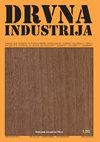Performance of ANN in Predicting Internal Bonding of Cement Particleboard Manufactured from Giant Reed and Bagasse
IF 0.8
4区 农林科学
Q4 MATERIALS SCIENCE, PAPER & WOOD
引用次数: 1
Abstract
The present article investigates the microstructure of the cement matrices and the products of cement hydration by means of scanning electron microscopy, Fourier transform infrared spectroscopy and X-Ray diffraction. Then, the internal bonding strength (IB) is measured for the mixtures containing various amounts of nanosilica (NS), reed and bagasse particles. Finally, an Artificial Neural Network (ANN) is trained to reproduce these experimental results. The results show that the hardened cement paste including NS features the highest level of C-S-H. However, it has a lower level of C-S-H polymerization if reed or bagasse particles are applied. A relatively new dense microstructural degree is considered in the cement pastes containing NS, and a lower agglomeration is observed in the samples including reed or bagasse particles with NS. According to the microstructural analysis, the addition of NS to the samples containing reed or bagasse particles increases the unhydrated amount of C2S and C3S in the cement paste due to the decrease in the water needed for fully hydrated cement grains through portlandite (Ca(OH)2), C-S-H and ettringite increase. Besides, it is shown that the ANN prediction model is a useful, reliable and quite effective tool for modeling IB of cement-bonded particleboard (CBPB). It is indicated that the mean absolute percentage errors (MAPE) are 1.98 % and 1.45 % in the prediction of the IB values for the training and testing datasets, respectively. The determination coeffi cients (R2) of the training and testing data sets are 0.972 and 0.997 in the prediction of the bonding strength by ANN, respectively.人工神经网络在预测巨型芦苇和蔗渣水泥刨花板内部粘结中的性能
本文采用扫描电子显微镜、傅立叶变换红外光谱和X射线衍射等方法研究了水泥基体的微观结构和水泥水化产物。然后,测量含有不同量的纳米二氧化硅(NS)、芦苇和蔗渣颗粒的混合物的内部结合强度(IB)。最后,训练了一个人工神经网络来重现这些实验结果。研究结果表明,含NS的硬化水泥浆体具有最高的C-S-H含量。然而,如果使用芦苇或蔗渣颗粒,其具有较低水平的C-S-H聚合。在含有NS的水泥浆体中考虑了相对较新的致密微观结构程度,并且在包括含有NS的芦苇或蔗渣颗粒的样品中观察到较低的团聚。根据微观结构分析,向含有芦苇或蔗渣颗粒的样品中添加NS会增加水泥浆中C2S和C3S的未水合量,这是由于通过钙矾石(Ca(OH)2)、C-S-H和钙矾石增加而使水泥颗粒完全水合所需的水减少。结果表明,人工神经网络预测模型对水泥刨花板IB的建模是一种有用、可靠、有效的工具。结果表明,在训练和测试数据集的IB值预测中,平均绝对百分比误差(MAPE)分别为1.98%和1.45%。在用ANN预测结合强度时,训练和测试数据集的确定系数(R2)分别为0.972和0.997。
本文章由计算机程序翻译,如有差异,请以英文原文为准。
求助全文
约1分钟内获得全文
求助全文
来源期刊

Drvna Industrija
MATERIALS SCIENCE, PAPER & WOOD-
CiteScore
1.80
自引率
9.10%
发文量
32
审稿时长
>12 weeks
期刊介绍:
"Drvna industrija" ("Wood Industry") journal publishes original scientific and review papers, short notes, professional papers, conference papers, reports, professional information, bibliographical and survey articles and general notes relating to the forestry exploitation, biology, chemistry, physics and technology of wood, pulp and paper and wood components, including production, management and marketing aspects in the woodworking industry.
 求助内容:
求助内容: 应助结果提醒方式:
应助结果提醒方式:


